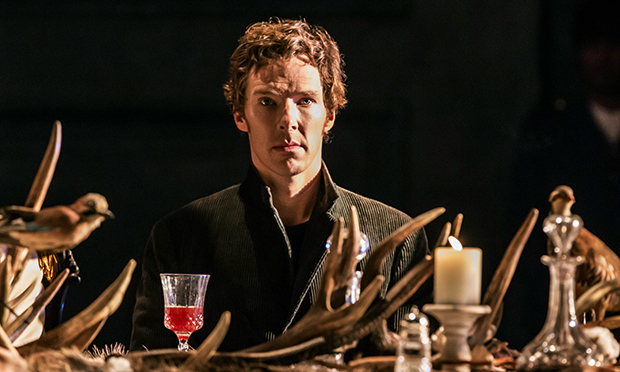Hamlet – stage review: 'ambitious, visually lavish and perfectly-pitched'

Benedict Cumberbatch as Hamlet in the Barbican’s production of the Shakespeare play. Photograph: Johan Persson
It may be the magnetic pull of its lead actor that made this the fastest-selling theatre show in UK history, but in the Barbican’s Hamlet Benedict Cumberbatch is just one of the heavy hitters in a knock-out production.
Lyndsey Turner’s highly-anticipated (and already controversial) production of one of Shakespeare’s most often-performed plays is ambitious, visually lavish and perfectly-pitched. Ciaran Hinds’ Claudius, Anastasia Hille’s Gertrude, Jim Norton’s Polonius and Karl Johnson as the gravedigger are just some of the highlights in an ensemble that bring fresh humour, irony and energy to some of the most well-worn lines in the English language.
They’re supported by yet another impressive set design from Es Devlin, whose extraordinary work you might recognise from previous London shows including The Master and Margarita (also at the Barbican), Chimerica and The Nether, all the way to Jay Z concerts. The music, a powerful part of the show, comes from renowned producer and composer Jon Hopkins, plus Luke Halls on video, Jane Cox on lighting and Christopher Shutt on sound. It’s an electric performance that chews you up and spits you out three hours later.
The best thing about Benedict Cumberbatch in this role is that you don’t feel like you’re watching Benedict Cumberbatch. Despite reports his fans flew from as far as LA to queue for a chance of picking up tickets and his (now virally-shared) appeal to audiences not to film the performance, his celebrity doesn’t overshadow the play.
Maybe it’s because he manages to stay relatively private in the public eye, which is something that made watching Jude Law in the same role quite distracting for example. Maybe it’s because the sheer scale of the production means it hangs less on its lead. At any rate he delivers a powerful, very human and at times hilarious performance in what many see as a milestone role in an actor’s career.
Dressed in scruffy student clothes, sitting alone listening to Nature Boy on his record player as the play opens, he plays a very relatable Prince of Denmark, wrestling with the death of his father and sudden remarriage of his mother to his uncle Claudius. The uncle who killed his father and whom he will spend the rest of the play finding the resolve to take revenge upon.
It’s an energetic performance, as Hamlet shapeshifts with agility from self-loathing despair to rage to comedy. His antic disposition, the method to his ‘madness’, is first manifest with him dressed as a toy soldier and marching on the banquet table. It’s very funny, hinging in many ways on the comic chemistry with Polonius, which is perfectly timed.
During his many speeches there’s clever choreography and lighting to make it seem like the rest of a scene is carrying on in slow motion while he performs soliloquies in the spotlight, which means the play loses none of its momentum. His soliloquies have, of course, been at the centre of heated debate in theatreland over the past weeks.
The play’s multiple re-writes and length (in full it’s four hours and 4,000 lines) mean most productions cut it down, making the text more than usually open to interpretation. Not too much though, it seems, with the production u-turning on its experiment with putting Hamlet’s famous “To be or not to be” soliloquy into Act 1.
One of the biggest stars of the show has to be Es Devlin’s set. It takes advantage of the sheer size and scope of the Barbican’s performance space to house two-storey royal palace rooms at Elsinore in which the play opens. There are striking visualisations of the “unnatural” death of the rightful king and imagery of corruption that underpin the play, including entire blanched trees with dead white flowers hanging suspended upside-down over the new King’s banquet table and dead creepers choking the staircase.
In the second act the entire stage scene is demolished, making Ophelia’s grief and unravelling wits all the more poignant as she treads barefoot in the smoking remains of the castle. Later the same rubble mountain landscape becomes a graveside during the ‘Alas, poor Yorick’ scene and a bleak battle camp as Fortinbras’ men march toward Elsinore. The use of video projection and lighting is particularly striking here, played out across Devlin’s epic designs.
There are moments of breath-taking stagecraft, including the tumultuous close of Act 3 and the bloodbath of the fencing match that will see most remaining characters die. The last, especially, is a masterpiece of choreography and stagecraft that sees the cast swirling in a whirl of light and shadow as Hamlet finally avenges his father.
A triumph all told.
Hamlet is at The Barbican, Silk Street, EC2Y 8DS until 25 October
